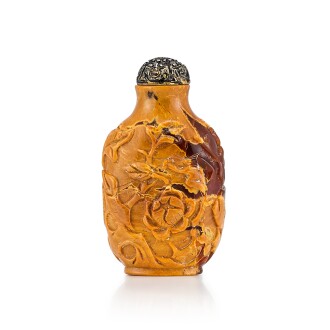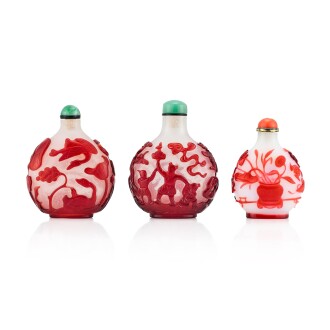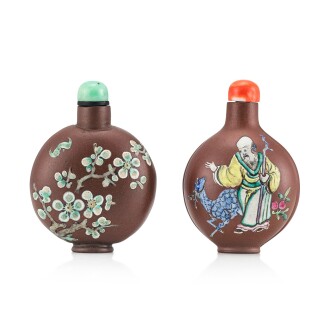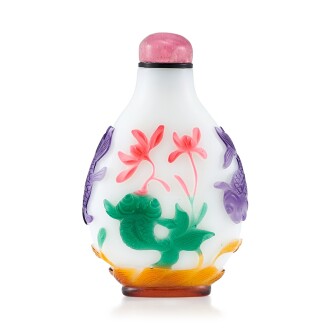F
or those who observe the Lunar New Year, the celebrations signify new beginnings and family togetherness. In anticipation of the coming spring, the customary exchange of gifts is often a wonderful way to share hoped-for blessings for the near future and sweep away the ills of previous year. Selects work from an online auction of Snuff Bottles (5–10 February, Hong Kong) are perfect and portable ways to convey these ideas of good fortune, family harmony, prosperity, and peace. From the specially-prepared foods in a shared feast to the seasonal plants and decorations, these observances have become such a matter of course that most do not even give their meaning a second thought. Through the lens of Chinese art, we identify some of the origins behind these symbols, many of which are rooted in centuries-old agrarian tradition. Read along with us to test how many of these you already know.
Year of the Ox
Festivities in observance of the Year of the Ox will begin on 12 February 2021. The theme of the ox, perhaps the strongest and most reliable of zodiac animals, is already familiar to most, and we won't venture too far on the well-trod ground of the traditional zodiac. There is a nice overlap, however, in Chinese art with an emphasis on agriculture as the foundation of civilization. Because of their important role in agriculture and their close relationship with humans, the oxen or water buffaloes are emblematic of pastoral life as well as the coming of spring. It follows that the abundance and health of these animals then represent a nation’s development, stability, and wealth. Well-known examples of the theme in Chinese art includes Tang dynasty painter Han Huang's (732-787) masterpiece The Five Oxen, currently in the Palace Museum Beijing and a work thought to be the earliest extant Chinese painting on paper.
Colors
Red and gold bring a touch of life and richness to any important celebration. At the beginning of the new year as well as other joyous occasions, such as weddings and festivals, everything would be awash with scarlet and vermilion. Beyond its enduring appeal, red holds specific and important meaning culturally. The auspicious color gives off warmth, bringing to mind the fire and the sun, and thus has associations with vitality, youth, and fertility. Because of its striking nature, red is universally identified as having intense qualities – i.e., passion, love and power.
Flowers
Brighten the home with auspicious blooms, as the saying goes “when flowers bloom, prosperity follows.” Seasonal favorites for the new year include red flowers – such as red azalea, camellia, carnation, cyclamen, and gladiolus – but if you aren't a stickler for tradition, most flowers hold the promise of spring and can bring happiness to a household.
Wax plums, narcissus, quince, and small peach trees are among the most popular during the holiday season because of their associations with immortals. The symbolism of such trees, for example peaches and peach blossoms, are significant in art because they are symbols of immortality and longevity. In bygone ages, the wood of the peach tree was fashioned into arrows, amulets or other charms to ward of harmful elements during the new year. The peach tree is also associated with fertility, as a branch of blossoms augurs the arrival of fruit – a propitious metaphor for expectant parents in the coming year.
The plum blossom is another important symbol because it offers the first blooms of the new year. Many a home will be festooned with sprays of the delicate flowers to mark the end of winter as a symbol of renewal and perseverance. It is important to note that that the plum tree is, along with the pine and the bamboo, part of the Three Friends of Winter. The trio is a popular subject for Chinese works of art, symbolizing endurance in adverse conditions.
Auspicious Blessing
Many foods prepared for the family feast during new year has symbolic meaning and traditional stories behind them. Often they will be chosen for the names, which would have homophonic wordplay with blessings – i.e., dried oysters for good business, dried bean curd for abundant, prosperity, mandarin oranges for great fortune, and so on. For example the fish is an enduring symbol during the new year, because it’s homophonous with the word “surplus” and thus bestows the blessing “may you have abundance year after year.” As in celebrations and festivals, auspicious meanings are a rich aspect in Chinese works of art, and there are easily more than hundreds of fruit, vegetables, trees, flowers, animals, mythical creatures and everyday objects that together they make up a visual language. Often these ideas refer to four-character aphorisms or poetic phrases that convey blessings of good luck, marital or family harmony, fertility, career success, longevity, peace, and prosperity.

















